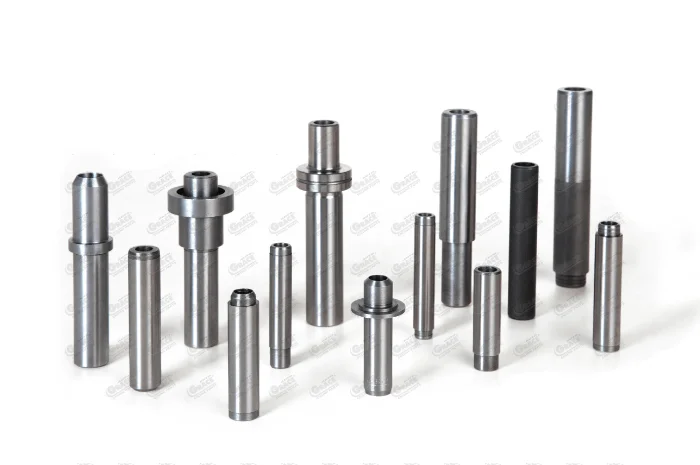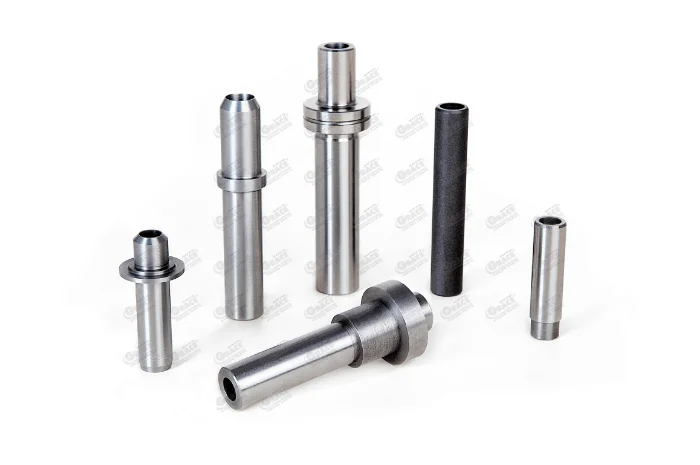Are you a distributor or importer?


Guiding Motion, to the Last Micron
Valve Guides are hollow cylindrical components that fit into the cylinder head, into which the valve is then inserted. They guide the reciprocating motion of the valves, and ensure correct alignment of the valve seating ring with the valve seat insert. Hardness and concentricity of inner and outer surfaces of the guide are the defining characteristics of a good quality valve guide.
Valve Guides serve following functions in an IC engine:
Valve guide to valve stem clearance is one of the most important factors affecting all above functions as well as the tribologic situation in the guide-valve system. Thus stem diameter must be matched with guide bore to achieve smallest possible play without seizing the valve due to insufficient lubrication. Typical clearance values are as shown below.
| VALVE STEM DIA (mm) | INTAKE (μm) | EXHAUST (μm) |
|---|---|---|
| 6-7 | 10-40 | 25-55 |
| 8-9 | 20-50 | 35-65 |
| 10-12 | 40-70 | 55-85 |
Size Range of AutoGRACE® Brand valve guides:
| SPECIFICATION | FROM | TO |
|---|---|---|
| Bore (mm) | 4.0 | 20.0 |
| Outer Diameter (mm) | 8.0 | 30.0 |
| Length (mm) | 25.0 | 200.0 |
Garima Global supplies components for a wide variety of on-road, off-road, industrial and stationary applications such as: automotive (light duty) and light commercial, trucks (heavy duty), tractors (agricultural), earthmoving and construction machinery, generators, irrigation pumps, and defence / special purpose vehicles.
The brands for which we manufacture and export aftermarket products are Caterpillar, Chevrolet, Chrysler, Citroen, Cummins, Daewoo, DAF, Daihatsu, Detroit Diesel, Deutz, Fiat, Ford, Hino, Honda, Hyundai, International, Isuzu, Iveco, John Deere, Kamaz, Kia, Komatsu, Kubota, Land Rover, Leyland, Lister Petter, Lombardini, Mack, Mahindra, MAN, Massey Ferguson, Mazda, Mercedes Benz, Mitsubishi, Navistar, Nissan, Onan, Perkins, Peugeot, Renault, Scania, Suzuki, Tata, Tatra, Toyota, Ursus, UTB, Volvo, Yanmar and Zetor, amongst others.
Garima Global also export parts for air-brake compressors like Wabco, Bendix, Knorr, Cummins, Clayton Dewandre, Mercedes, Midland etc.
Garima Global has developed an extensive range of components for engine, braking, transmission, suspension, steering, chassis, electrical, lighting and other automotive sub-systems. To assist our customers with choosing the right product for their requirements we have published comprehensive catalogs with engine / vehicle models, interchange with references of OEMs and other popular aftermarket brands, fitment dimensions and other technical data. We strongly encourage you to contact us with your specific requirements so that we can email you the relevant catalogs, and we look forward to starting a mutually beneficial business relationship with you soon!
By far the predominant material used in valve guides due to its cost effectiveness and excellent tribologic properties. Microstructure is predominantly pearlitic and free graphite flakes act as an embedded solid lubricant. GG25 and GG30 are popular CI grades for valve guides.
Mostly Cu-Zn alloys are obtained as a bar stock or tube and then turned to make valve guides. Advantage of this material is good machinability and superior thermal conductivity. Mn and Si may be added as alloys to improve wear resistance. However, hardness and tensile strength of this material is inherently lower compared to others.
Since this material is highly porous, lubricating oil fills up the pores to provide basic lubrication between stem and guide. The guides can also be charged with oil by dipping in hot oil bath or oil impregnation – first placing guide in a vacuum chamber which is then flooded by heated oil. Increasingly more and more guides are being manufactured by sintered metal technology.
CHEMICAL COMPOSITION
| ELEMENT | CAST IRON GG25 |
SINTERED METAL |
BRASS CuZn40Al2 CuZn37Mn3Al2PbSi DIN 17660 2.0550 |
|---|---|---|---|
| Carbon (%) | 3.00-3.40 | 1.50-3.00 | 56.50-59.00 |
| Silicon (%) | 1.80-2.50 | 0.40 MAX | 0.30-1.00 |
| Manganese (%) | 0.60-0.80 | 1.20 MAX | BAL |
| Sulphur (%) | 0.00-0.12 | 0.60 MAX | 1.30-2.30 |
| Phosphorus (%) | Min 0.35 | 0.80 MAX | 1.40-2.60 |
| Chromium (%) | - | - | 2.00 MAX |
| Molybdenum (%) | - | - | - |
| Nickel (%) | - | - | - |
| Vanadium (%) | - | - | - |
| Copper (%) | - | 4.00-10.00 | 56.50-59.00 |
| Magnesium (%) | - | 0.50 MAX | - |
| Tin (%) | - | 0.80 MAX | - |
| Aluminum (%) | - | - | 1.30-2.30 |
| Lead (%) | - | - | 0.80 MAX |
| Zinc (%) | - | - | BAL |
| HARDNESS (BHN) | 190-250 | 120-200 | 150-170 |
| THERMAL CONDUCTIVITY (W/mK) | 38-45 | 21-48 | 46-100 |
| COEFFICIENT OF THERMAL CONDUCTIVITY (10-6 K) | 9-11 | 9-13 | 18-22 |
AutoGRACE® valve guides are manufactured by the leading OEM and OES manufacturers of valve guides in India that adhere to the highest quality specifications. Garima Global develops these guides in close partnership with our customers and vendors, and ensures stringent quality check inspections before delivery to customers.
Valve guides blanks may be obtained by one of the following processes.
The traditional method for producing blanks for cast iron guides, they are generally cast in the form of solid bars with notches cast into them. The notches help to break the bar into individual pieces for each guide. Solidification of the bars is controlled closely to achieve correct hardness and microstructure.
Readily available for non-ferrous guides, principally in CuZn40Al2 grade.
Powder metal is heated to semi-liquid phase and then pressed to fuse it together to form blanks which require minimal turning and is quite porous. Copper or other hardening material may be infused into the pores to improve wear resistance.
The blanks are then machined to achieve the required dimensions and geometrical shape. Since the alignment of the valve is strongly related to the concentricity of the inner and outer diameters of the guide, both surfaces are super finished – bore by reaming process and OD by centreless grinding. AutoGRACE® valve guides are also available in semi-finished condition where the bore can be finished after fitment into the head.
To increase the oil carrying capacity, a spiral groove or multiple grooves of different pitches may be machined into the bore of the guide.
A chamfer or step may be provided to aid the pressing of the guide into the head on the outer surface. Toward the camshaft end a large variety of profiles are used depending on the type of valve stem seal being used. Flanges may also be machined into the outer diameter that serve as a locating feature while the guide is being pressed into the head.
The complete guide is coated with manganese phosphate to protect against corrosion and aid lubrication during engine run-in phase.
For CNG and LPG engines that burn fuel at a much higher temperature, cast iron may not provide sufficient resistance against thermal degradation of material properties. During Nitriding or Tuff-Triding, nitrogen is diffused into the surface of the guide to form a 5-30 micron layer of wear-resistant iron nitrides.
Correct installation of the guide into the head is just as important as its manufacturing to achieve the perfect alignment of the valve with the seat. The following thumb rules must be implemented:
AutoGRACE® valve guides undergo stringent checks at our in-house lab before dispatch to our discerning customers globally on the following important parameters, among others:
Start the
conversation.
Every beautiful relationship starts with a simple hello. So let’s chat. It might just be the start of something memorable.